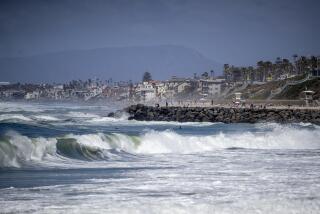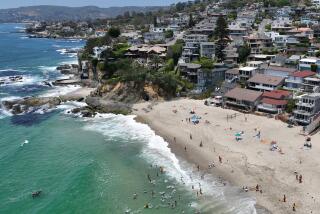Kicking Sand on Beachgoers’ Plans
Some come to Southern California’s golden sands in search of a party. Others seek freedom from the stress of traffic, work and other trials of daily life. But as people begin flocking to the beaches this Memorial Day weekend, they will find a little less freedom in their summer fun. Six communities this year have slapped a variety of new regulations on beachgoers, creating a patchwork of rules as diverse as the coastline itself. And at least three others, as well as the state beach system, are considering new rules.
San Diego is one of the few places where one can still drink beer on the beach. But starting in June, all-night bonfires will be no more.
For the record:
12:00 a.m. June 4, 2004 For The Record
Los Angeles Times Friday June 04, 2004 Home Edition Main News Part A Page 2 National Desk 1 inches; 51 words Type of Material: Correction
Smoking at the beach -- Articles in the California section Sunday and May 22 about smoking prohibitions on Southern California beaches reported that San Clemente had set aside smoking areas on the city’s beach and pier. Such zones had been proposed, but the City Council voted unanimously to reject designated-smoking areas.
The city also is banning another local ritual: bringing household furniture -- everything from coffee tables to recliners -- to the sand to create an outdoor beach house.
Up the coast in San Clemente, the city is dividing the beach into smoking and nonsmoking sections. Santa Monica’s smoking ban applies to the city’s entire coast, much to the chagrin of beach business owners, who fear it will keep people away.
A tour along 230 miles of California coast finds grudging acceptance for the new laws, along with sadness that the regulations of everyday life are creeping into a place they consider an escape.
“This is a place where people can get away from society. To try to impose rules is ridiculous,” said Brooke Anderson, 29, as she strolled with her Rhodesian Ridgeback, Kianga, near the jutting cliffs of Isla Vista’s beach in Santa Barbara County.
But experts said that, from polluted water to trash on the sand, society is slowly recognizing that beaches are fragile places that need protection.
“Maybe people are going to feel persecuted about it, but we have to start changing people’s idea of the beach as a playground but as part of a shared resource,” said Jennifer Wolch, director of the University of California’s Center for Sustainable Cities.
San Diego
San Diego’s city beaches, narrow strands of sand separated by a concrete walkway from rows of bustling surf shops, pizza joints and boxy apartments, have a summer tradition.
Every Fourth of July, thousands converge on the dunes overlooking the beaches, dragging old furniture -- couches, coffee tables, love seats, even lamps and generators. Then they drink the night away.
After the fireworks, they gather around one of the beach’s 114 fire rings, drink some more, and burn the furniture.
“It’s all in good fun,” said Tim Beckstrom, 24, who has gone to the parties for the last eight years.
But police have become concerned about rowdiness.
First, officials tried to ban alcohol. San Diego remains one of the few beaches in the state to still allow drinking, and many residents take pride that their sands are free of such a rule.
So when the proposed ban was announced, beachgoers and coastal merchants rose up against it.
“The alcohol debate was so divisive and so emotional,” said City Councilman Michael Zucchett.
So the alcohol ban was dropped. Instead, the city decided to prohibit furniture on the beach. It also closed down the fire rings after midnight.
For Steve Sangrey, 31, who has dragged his own tents and canopies to the shore for the last four years, those restrictions are as odious as outlawing drinking or smoking.
Beachgoing is “a community event; everybody just hangs,” he said. “It’s our holiday.”
Sangrey, who said he usually stayed until after 4 a.m., said the fire ring curfew was extreme.
Midnight, he said, is “when people start getting their second wind.”
Igor Poshiv, 36, who lived in Los Angeles for two years before moving to San Diego five months ago, said he thought the laissez-faire tradition of the city’s beaches would prevail. “In San Diego, I was shocked that someone could come with a beer,” he said. “There’s so much freedom here.”
San Clemente
This small coastal town was one of the first municipalities in California to consider a smoking ban. Built on a rolling hill at the southern end of Orange County, San Clemente has a maze of winding streets that meander past Spanish Colonial bungalows to the coast.
Backers of the ban thought they would face little resistance just north of Camp Pendleton. But they were wrong.
“I don’t think this country is in a position to pass a law making smoking cigarettes a crime,” Steve Schwartz, chairman of the parks commission, told the dozens of ban proponents who gathered in February.
The commission rejected the ban, shocking advocates who had just won a victory in Solana Beach, which was the state’s first municipality to outlaw beach smoking.
“We learned a very special lesson: All these little cities are very different,” said Molly Bowman, the local advocacy director for the American Heart Assn.
But the heart association and other groups continued to push for a ban, eventually striking the compromise that led to smoking and nonsmoking sections. All sand areas are off-limits to smokers, but sections of the pier still allow smoking.
The compromise, approved by the City Council last week, pleased antismoking advocates but disappointed smokers.
Fisherman Terry Melum, 49, said smoking was part of his routine. As he waited for the fish to bite, Melum said he loved taking a drag on his Marlboros.
“I think they’ve gotten out of hand,” he said as he took a last puff before tossing his cigarette into a trash can nearby.
Santa Monica
This bustling beach city seems a world away from the quiet sands of San Clemente. The Santa Monica Mountains serve as a backdrop to thousands of surfers, sunbathers and swimmers, and the fishermen who use the mile-long pier.
Robert Berger, chairman of Los Angeles County Smoke Free Beaches, thought bringing the ban to this beach would be natural in a city known as environmentally friendly. The city had already banned cigarettes from parks.
But although city officials were easy to persuade, business owners on the pier were not. They felt that a complete smoking ban would cost them customers.
“It will probably dissuade a lot of people to come down to the pier,” said John Volaski, owner of Santa Monica Pier Bait & Tackle.
Despite the criticisms, the City Council banned smoking on beaches and piers -- even in outdoor dining areas. Violators face fines of up to $250.
The ban, which took effect last week, was supported by many sunbathers on a recent day.
Diana Hoaglin, 36, and Kimberly Moody, 37, on a visit from Humboldt County, said the ban made for a better beach experience.
“I don’t want to breathe smoke,” Hoaglin said. “I think it would be annoying to bring your family and have some idiot drinking and smoking. This is a family place.”
But beach businesses have not given up their fight.
The Santa Monica Pier Restoration Corp., which represents businesses on the pier, will ask the City Council to consider 11 different smoking sections, all 5 feet long by 15 feet wide. They based their plans on an elaborate study of wind conditions and pedestrian flows.
The study found that Santa Monica has fairly consistent wind patterns, making it possible to create smoking areas in locations that would not send the smoke into nonsmoking areas.
Carpinteria
This tiny town nearly 100 miles north of Los Angeles is the latest municipality to consider a smoking ban.
The beach here is largely untouched by commercial development. There is no public pier, no boardwalk, no string of shops lining the sand’s edge. Only a row of small cottages.
But not even this town can escape the crowds that materialize during the summer -- many from the sweltering Central Valley.
Carol Spears, 45, a resident of Carpinteria for 19 years, said her city’s beach -- peaceful and only sparely used much of the year -- had “wall to wall” people during the summer. The no-smoking rule, she said, would force visitors to respect the beach.
“I think there are a lot of people who would truly support [a smoking ban] because they like to have control of the area,” she said.
“Maybe some of those bans wouldn’t happen if people would be more careful. Maybe if they were a little bit better about taking care of things, there would be more freedoms.”
A few steps down the beach, Lynette Woodfin, 40, played with her children near a lifeguard stand. They had driven from Bakersfield for the day.
Woodfin doesn’t smoke, but she thinks the city would be making a mistake by banning cigarettes. The way she sees it, the beach is the ultimate place to kick back, and smokers should not be left out.
“I don’t know where you’re supposed to smoke,” she said. “If that’s the way you relax, it’s like taking away your rights.”
More to Read
Sign up for Essential California
The most important California stories and recommendations in your inbox every morning.
You may occasionally receive promotional content from the Los Angeles Times.










